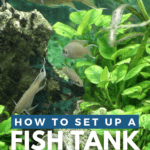Watching a tank full of beautiful fish swimming around in the crystal clear water of a freshwater fish tank setup is a relaxing, satisfying way to end your work day. But successfully setting up a fish tank is not as easy as many beginners think.
Read this guide to learn how to set up a fish tank and avoid all those costly beginner aquarium hobby mistakes!
How To Set Up A Fish Tank
Setting up a new fish tank means more than just filling the aquarium with water and tossing a few fish into it!
Here’s how to do it!
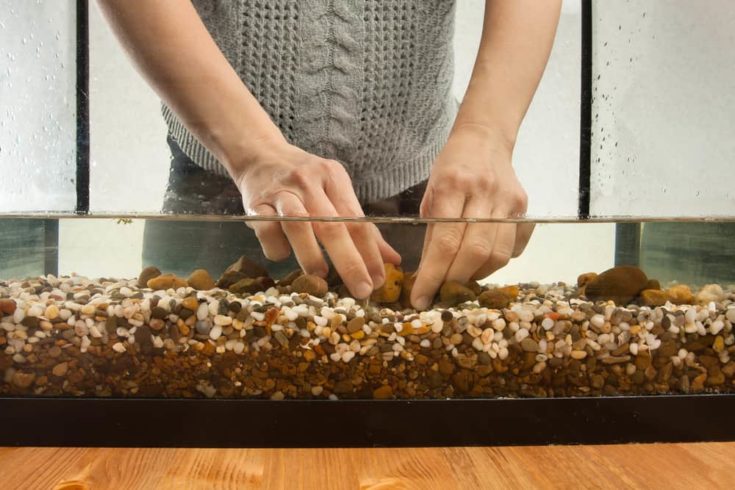
Setting Up the Aquarium
Before you start, you’ll need to take a trip to your local fish store and buy everything you’ll need, as follows:
- Aquarium and cabinet or stand
- Gravel or sand substrate
- LED lighting unit
- Filter system
- Water dechlorinator
- Heater (if you’re keeping tropical fish)
- Aquarium thermometer
- Decorations, such as driftwood, twisted roots, smooth stones, etc.
- A selection of live plants
- A fish net
Now, you’re ready to set up your fish tank!
Where To Place Your Fish Tank
Next, choose a suitable location for your aquarium:
- Don’t put the aquarium in direct sunlight. That encourages algae growth and could make the water too warm.
- Avoid heat sources and drafts.
- Choose level ground so that the tank doesn’t fall over.
- Avoid doorways or spots where running pets or children could knock over the tank.
- Pick a spot close to enough main power outlets so that you can plug in your heater, filter, and lights.
A place close to your kitchen is a good choice so that you can access a sink and faucet for partial water changes.
Set Up The Tank
1. Clean The Aquarium
Use a clean cloth and warm water to wipe down the inside of the aquarium.
Don’t use chemical cleaners!
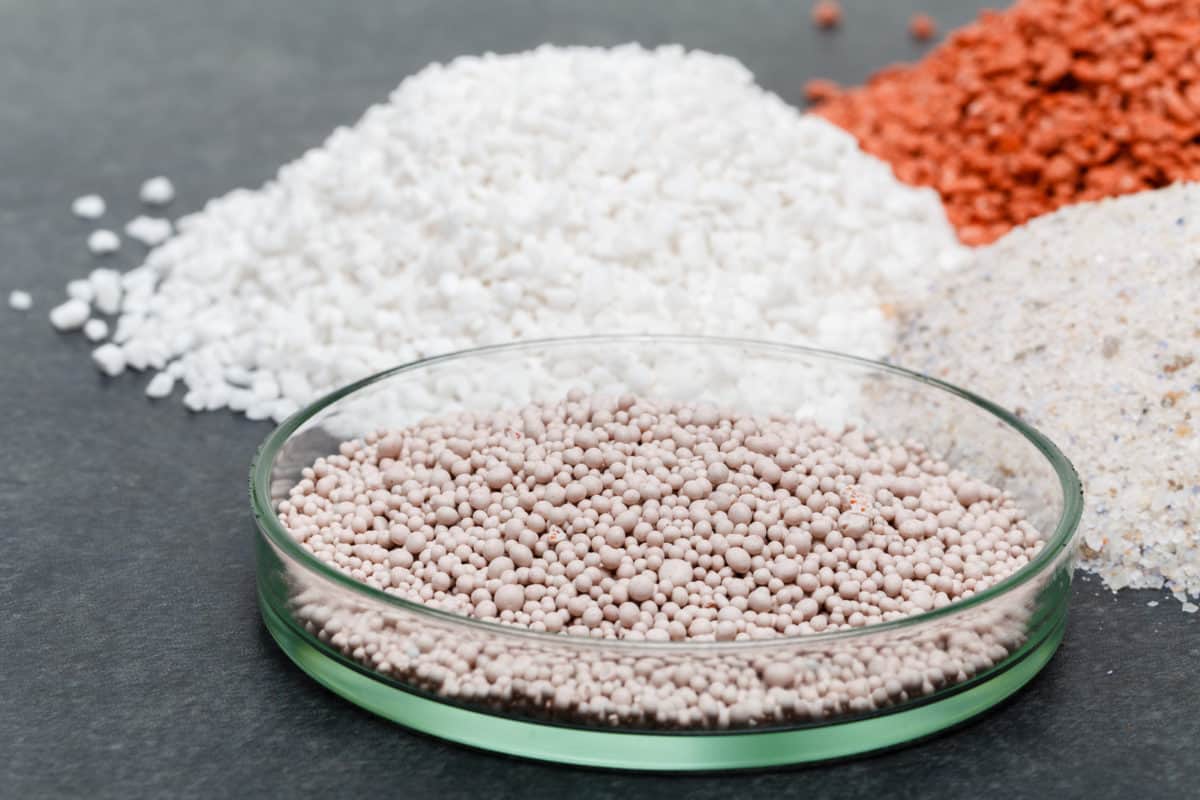
2. Wash The Substrate
Rinse the substrate in clean, running water to get rid of dust.
If you’re using an undergravel filter, fit it now.
3. Put The Substrate Into Your Aquarium
Put a few inches of the substrate into your fish tank.
4. Wash And Add Aquarium Ornaments
Wash your ornaments under running water and put them into the aquarium.
5. Fit The Heater And Filter
Add the heater and filter but don’t turn them on yet.
6. Add Water
The water you add to your tank must be treated with a dechlorinator first to get rid of any chloramine and chlorine that could harm your fish.
I always pour the water over an upturned plate to prevent it from displacing the substrate.
7. Add Plants
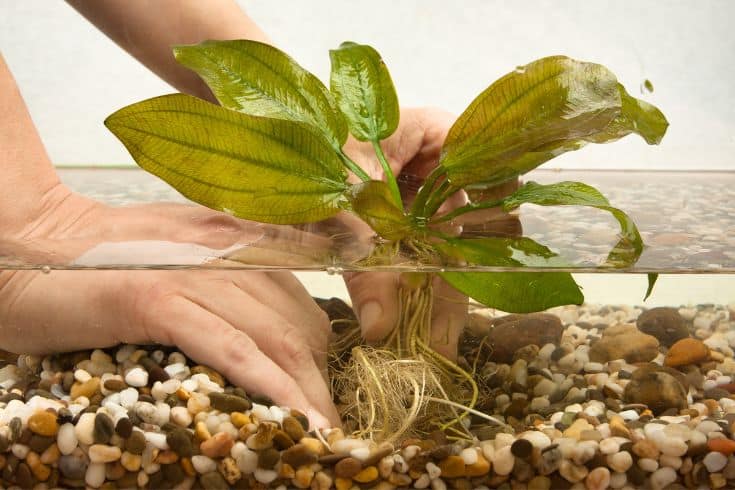
Add live plants to the tank. Put the tallest at the back and sides and the smaller ones toward the front of the aquarium.
Remember that live plants need eight to ten hours of light every day for photosynthesis, so set your LED light timer accordingly.
8. “Seed” The Water
To start the nitrogen cycle, add a little pure ammonia or some fish flakes to “seed” the water.
9. Switch On The Heater And Filter
Switch on the heater and filter.
10. Allow The Aquarium To Cycle
Before you can add any fish, you need to allow the aquarium cycling process to complete.
Use an aquarium water testing kit to check the levels of ammonia, nitrite, and nitrates in the water. Once ammonia and nitrites are zero and nitrates are 20 ppm or less, you can add a few small fish.
Leave it a few weeks before adding more fish to avoid overloading the biological filter.
Common Mistakes Beginners Make
Here’s a list of common schoolboy errors beginners make so that you don’t make them!

Adding Fish Before The Aquarium Is Ready
Your tank must be fully cycled before you add any livestock!
If the tank is not cycled, you risk causing an ammonia spike that will kill all your fish.
Ammonia and nitrites must be zero, and nitrate levels at 20 ppm or less.
Adding Fish Without Acclimating Them First
Most fish are susceptible to temperature shock, and to prevent that, you must acclimate your fish to their new home before adding them to the aquarium.
Open the top of the fish’s transport bag to allow air inside. Allow the bag to float on top of the water for 15 minutes so the water temperature gradually equalizes. Now, release the fish into the aquarium.
Buying A “Small” Aquarium
Contrary to popular belief, a small tank is not as easy to care for as a larger aquarium. So, I suggest you begin with a 30-gallon or 60-gallon tank, depending on the space you have available in your home.
Buying The Aquarium and Fish Together
Don’t make the mistake of buying the fish and the tank together. Your tank must cycle before you can put fish in it, or you risk killing your new pets.
If there’s a fish you particularly want, most fish stores will let you leave a deposit to secure the fish.
Impulse Purchases
I’ve made this mistake! You spot a gorgeous fish in the fish store and buy it impulsively. Don’t do it!
You must research your fish carefully to ensure they are all compatible before you part with your cash.
Underestimating The Running Costs
It’s not cheap to run a fish tank! Just take a look at the following running costs before you take the plunge:
- Electricity to run the filtration system, heater, and lights
- Fish food
- Aquarium water testing kit
- Fish medication
- Water dechlorinator
- Replacement filter media
- Replacement light bulbs

Not Understanding The Nitrogen Cycle
To avoid ending up with sick fish, you must understand how the nitrogen cycle works.
You can read an in-depth beginner’s guide to the nitrogen cycle at this link.
Accidental Poisoning
Many newbies to the fishkeeping hobby accidentally poison their fish!
Poisoning typically happens due to poor tank maintenance, including:
- Failure to perform weekly water changes
- Not maintaining and replacing filter media
- Not removing decomposing fish waste, plant debris, etc.
- Using too many chemicals
Not Using Live Plants
Living plants are an extremely beneficial addition to a fish tank. Live plants:
- Oxygenate the water
- Absorb harmful nitrates
- Provide hiding places for shy fish and fry
- Add aesthetic value to the tank
- Starve algae of nutrients
Using A Cheap Filter
Many beginners choose a fish tank starter pack that contains a filter. Sadly, many of those filters lack the power to circulate the water adequately through the tank.
Not Testing The Tank Water Regularly
With an immature setup, you must test the water daily. Once the tank has matured, you must check the water chemistry monthly.
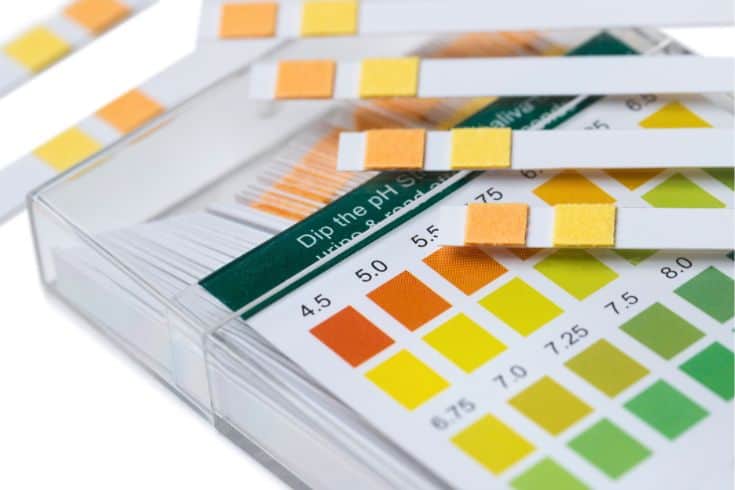
You need to check the following:
- Ammonia
- Nitrites
- Nitrates
- pH level
- Water hardness
Most fish mortality stems from poor water quality, so you mustn’t neglect to test.
Insufficient Water Changes
Partial water changes of between 25% and 40% should be performed every week, depending on your stocking levels and the fish species you keep.
Washing The Filter Media In Tap Water
Tap water contains chlorine or chloramine, which will kill any beneficial bacteria in your filter media. Without those bacteria, levels of ammonia, nitrites, and nitrates will spike, quickly killing your fish.
Changing All The Filter Media At Once
If you change all the filter media at once, you’ll remove the colonies of beneficial bacteria that process ammonia and nitrites, damaging the water quality and potentially killing your fish.
Overfeeding
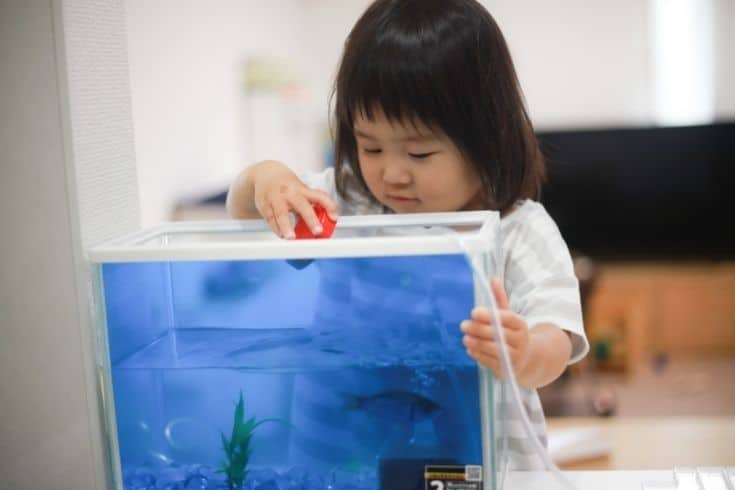
Don’t overfeed your fish, or you risk polluting the water with decomposing, uneaten fish food. Offer your fish only what they will eat in a few minutes, and feed them twice a day.
Keeping Incompatible Fish
Steer clear of keeping fish species that are not compatible. For example, if you mix large predatory fish with small peaceful ones, you can expect carnage!
Rearranging The Tank
Changing things up in your tank might look good, but it’s very stressful for your fish. So, keep things the same to maintain a happy community.
Failing To Treat Algae Properly
Algae grow in freshwater aquariums, coating the glass and decorations with green, red, or brown slime.
To prevent algae growing:
- Keeping the aquarium away from direct sunlight
- Include living plants in your aquascape
- Clean the glass with an algae magnet or scraper to prevent algae growth from accumulating
No Maintenance Schedule
Whatever type of setup you have, your tank needs the following maintenance to keep it clean and safe for your fish.
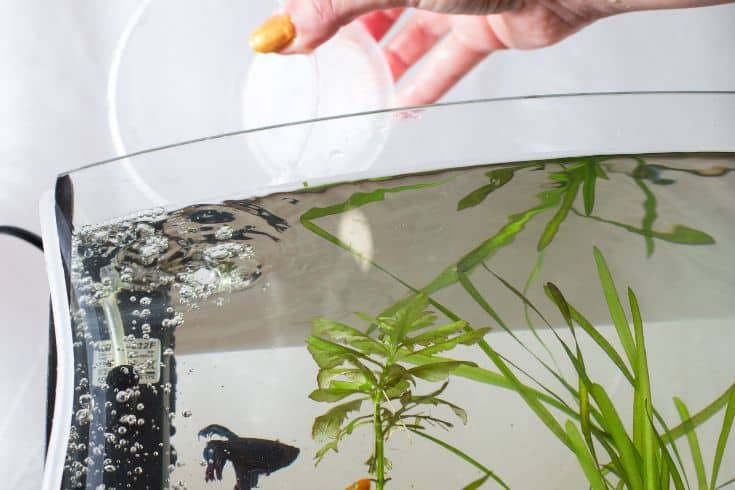
- Partial water changes
- Filter maintenance
- Tank cleaning
- Water chemistry tests
Allow at least one hour per week for tank maintenance.
Over-cleaning or Under-cleaning
Over-cleaning your aquarium strips away the healthy bacteria needed for efficient biological filtration. However, if you don’t clean your tank enough, the water quality will be poor, which is a costly mistake.
Failing To Quarantine New Fish
All new fish should be placed in a quarantine tank for a few weeks before being added to the main tank. That allows you to observe the fish for signs of disease so you know the fish are healthy before you introduce them to your existing stock.
Wrong Aquarium Positioning
As we mentioned earlier, you must choose the right location for your tank to ensure your fish are safe and healthy.
Not Using Suitable Lighting
Many fish don’t appreciate bright lighting, whereas some aquarium plants demand it. So, before buying fish and plants for your tank, research their lighting preferences.
Of course, if you don’t want to use real plants, you could use artificial plants instead.
Too Many or Too Few Decorations
If you want to keep species of schooling fish, you’ll need to allow plenty of swimming space uncluttered by aquarium plants and ornaments. However, shy fish will need somewhere to hide when they want to.
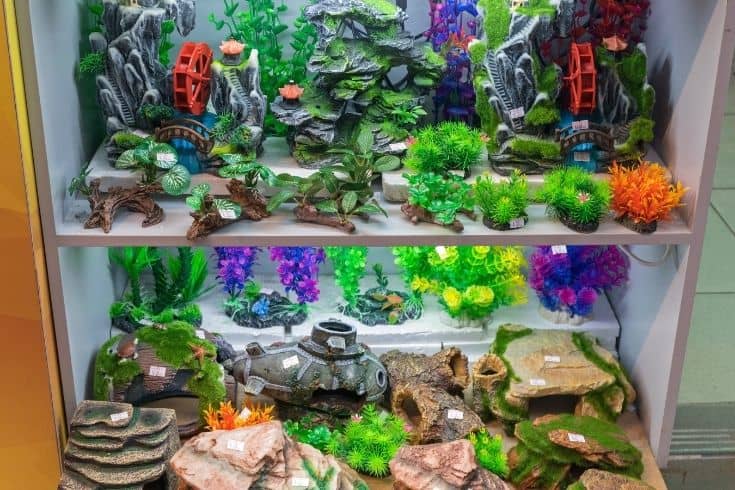
So, it’s essential to strike an appropriate balance.
Not Using An Aquarium Lid
Some fish can and do jump, so you’ll need a tank lid or a cover slide. In addition, dust and contaminants can fall into the water, and an open tank encourages water evaporation.
Adding Fish That Might Outgrow The Tank
The fish you find in fish stores are typically juveniles that can be just a fraction of their adult size.
Double-check that the fish you’re buying won’t get too big for your aquarium once mature.
Leaving Your Fish To Your Neighbours While On Vacation
Don’t be tempted to leave your precious fish in the care of your neighbors when you go on vacation unless they’re experienced aquarists.
Ensure your tank is clean, set a light timer, and use an automatic fish feeder so your fish get meals at pre-set times every other day.
Not Having A Back-up Plan For Power Failure
If the power to your aquarium fails, the filter and heater will stop working, the water quality will suffer, and your fish could go into temperature shock and potentially die.
Ensure you have a back-up plan, such as a battery pack to power your aquarium kit or blankets to wrap the tank in to keep your fish warm.
FAQs
Here are the answers to a few of the most commonly asked questions about setting up a new fish tank and beginner mistakes.
Q: How long does new tank syndrome take?
A: New tank syndrome can last for anywhere between two and 12 weeks.
Q: How long to wait to put fish in the tank after the water conditioner?
A: Water conditioner or dechlorinator is designed to dissipate within a bucket of clean water immediately. So, you can put your fish into the tank right after you’ve added the clean, treated water.
Q: How long should you wait before putting fish in a new tank?
A: You must not fill your new tank with fish until ammonia levels and nitrite levels are zero and nitrates are at around 20 ppm.
Q: Why is my new tank killing my fish?
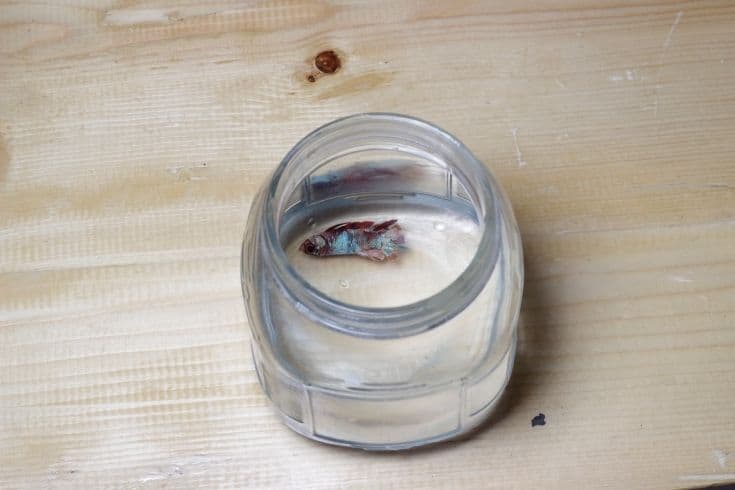
A: If your fish are dying right after you add them to your new tank, the problem is most likely with the water quality.
Test the water as described above to ensure the tank is fully cycled. Keep testing the water daily until the ammonia and nitrite levels are zero and nitrates are at around 20 ppm. Then it’s safe to add a few small fish.
Q: Can I use tap water for my fish tank?
A: Tap water is fine for use in fish tanks, provided you add a dechlorinator to the water to neutralize chlorine and chloramine first.
Final Thoughts
Did you enjoy our guide explaining how to set up an aquarium and the common mistakes made by beginners? If you did, please share it!
Before you begin your fishkeeping journey, research the fish you want to keep carefully, understand their care requirements, and check out all the valuable resources for you here at Tankarium.com!
If you have any questions about setting up a new tank, feel free to ask us in the comments box below!
